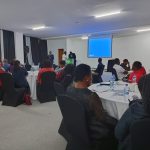But even though we were there to hear about health, my mind wasn’t always on diseases. One of the things I noticed on many of those trips was how little electricity there was. After the sun set, entire villages plunged into darkness. I remember seeing unlit streets in Lagos where people huddled around fires they had built in old oil barrels. I also remember thinking we should do something about this.

I didn’t know it then, but that was the beginning of my journey to working on climate change.
That phenomenon we witnessed—which is called “energy poverty”—is a real problem for 860 million people around the world. Our modern world is built on electricity. Without it, you are (quite literally) left in the dark. So, I started talking to experts about the issue and what could be done.
Two facts quickly became clear. First, the world would become a richer, healthier, and more equitable place if everyone had reliable access to electricity. Second, we need to find a way to make that happen without contributing to climate change.
That was nearly 14 years ago. Since then, I’ve spent a lot of time and resources exploring new ideas for reducing greenhouse gas emissions and helping people adapt to a changing climate.
When Warren urged Melinda and me to swing for the fences all those years ago, he was talking about the areas our foundation worked on at the time, not climate change. But his advice applies here, too. The world can’t solve a problem like climate change without making big bets.
Tackling climate change is going to demand historic levels of global cooperation, unprecedented amounts of innovation in nearly every sector of the economy, widespread deployment of today’s clean-energy solutions like solar and wind, and a concerted effort to work with the people who are most vulnerable to a warmer world. That won’t happen unless we decide what we’re going to do and how we’re going to do it.
In other words, we need a plan.
The good news is that we already have the ambition to get things done and goals to work toward. The ambition is evidenced by the amazing activism around climate, including last fall’s climate strikes. As for the goals, we can thank the Paris Agreement and all of the countries, cities, and states that have made bold commitments to zero out emissions by 2050.
So, what should the plan to meet that zero-emission goal look like? The answer is as complicated as the problem we’re trying to solve. But the short version breaks down into two buckets: mitigation and adaptation.
“So, what should the plan to meet that zero-emission goal look like? The answer is as complicated as the problem we’re trying to solve.”
Mitigation is all about reducing greenhouse gas emissions. The key to making that happen is a combination of deploying the things that work now and lots of innovation to create and scale the technologies we still need.
When people talk about solving climate change, they usually focus on reducing emissions—which is a good thing! We need zero-carbon alternatives in every sector of the economy, many of which don’t exist yet. Mitigation is, by far, the biggest challenge we need to figure out, and it’s great to see so much energy being put into how to zero out emissions. (I’m also hopeful that the innovation being done in this space will help provide electricity to more people.)
But solving climate change will require more than just mitigation. We also need to take on adaptation.
People all over the world are already being affected by a warmer world. Those impacts will only get worse in the years to come. The cruel irony is that the world’s poorest people, who contribute the least to climate change, will suffer the worst.
No one will be hit harder than subsistence farmers, who rely on the food they grow to feed their families and already live on the edge of survival. They don’t have the resources to withstand more droughts or floods, a disease outbreak among their herds, or new pests devouring their harvests. At 4 degrees Celsius of warming, most of sub-Saharan Africa could see the growing season shrink by 20 percent or more —and that’s just an average. In areas with severe droughts, the growing season could get cut even shorter.
The result will be less food, for both the farmers themselves and others who rely on the crops they grow and sell. More kids will suffer from malnutrition, and the already enormous inequity between the rich and poor will get even worse.
The Global Commission on Adaptation (which I’m co-chair of) recently released a report outlining steps that governments can take to support farmers in the decades to come. I’m also hopeful that our foundation’s work on agriculture will play a key role in helping farmers withstand climate change. Over a decade ago, we began funding research into drought- and flood-tolerant varieties of staple crops like maize and rice. These new varieties are already helping farmers grow more food in some parts of Africa and India, and more climate-smart crop options will become available in more places in the years to come.
But even if we succeed in increasing crop yields, the reality is that climate change will make it harder for many people to get the nutrition they need—which will, in turn, make them more susceptible to disease.
“The best thing we can do to help people in poor countries adapt to climate change is make sure they’re healthy enough to survive it.”
The best thing we can do to help people in poor countries adapt to climate change is make sure they’re healthy enough to survive it. We need to reduce the number of children who become malnourished and improve the odds that people who do suffer from malnutrition survive. That means making sure that people have access not only to the nutrients they need but also to proven interventions like vaccines, drugs, and diagnostics.
Organizations like Gavi and the Global Fund are going to play a big role in this by improving health in the most vulnerable places. If we’re going to prevent a climate disaster, climate-specific interventions and solutions aren’t enough. We need to be thinking about the indirect effects, too, like how a warmer planet will affect global health.
Climate change is one of the most difficult challenges the world has ever taken on. But I believe we can avoid a climate catastrophe if we take steps now to reduce emissions and find ways to adapt to a warmer world.























